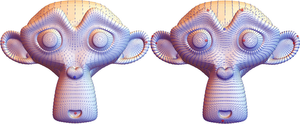Information
- Publication Type: Bachelor Thesis
- Workgroup(s)/Project(s):
- Date: June 2019
- Date (Start): 22. May 2018
- Date (End): 28. June 2019
- Matrikelnummer: 01226279
- First Supervisor: Philipp Erler
- Second Supervisor: Philipp Erler
- Keywords: Direction Fields, RoSy Fields, Global Approach
Abstract
We demonstrate the implementation of the Globally Optimal Direction Field algorithm by Knöppel et al. as a plugin for a geometry processing software. The plugin constructs N-RoSy fields of arbitrary degree by solving a smallest eigenvalue problem. For that, we use a sparse Cholesky solver and the Inverse Power Method. The field can optionally be aligned to the principal curvature induced by the geometry. We also added the option to use the improvements proposed by Pellenard et al. These improvements contain constraints imposed on certain areas of the mesh. A linear least squares approach is then used for solving the over-constrained system. Our main contribution is to clarify ambiguities we found in these papers, especially regarding the constraints.We tested the algorithm using meshes of different common sizes used in 3D modeling for the computation time and ease of usage. Although the algorithm is very fast the responsiveness starts to decline at about 6 * 10^4 polygons. We recommend not to use it on huge meshes or detailed 3D scans if fast results are important. The degree of curvature alignment can be difficult to adjust. However, together with fast results, different parameter settings can be tested relatively easy.
The results look very smooth and singularities are often located at geometric features. Using constraints helps to align the field to mesh boundaries, sharp edges or, if it is warped, to the principal curvature directions. Their use is very easy because the results are predictable. Only curvature constraints can sometimes be hard to predict and are best used in conjunction with other constraints.
Additional Files and Images
Weblinks
BibTeX
@bachelorsthesis{clemenz_2019_rosy_fields,
title = "Fast Rotationally Symmetric Direction Fields on 3D Surfaces",
author = "Christian Clemenz",
year = "2019",
abstract = "We demonstrate the implementation of the Globally Optimal
Direction Field algorithm by Kn\"{o}ppel et al. as a plugin
for a geometry processing software. The plugin constructs
N-RoSy fields of arbitrary degree by solving a smallest
eigenvalue problem. For that, we use a sparse Cholesky
solver and the Inverse Power Method. The field can
optionally be aligned to the principal curvature induced by
the geometry. We also added the option to use the
improvements proposed by Pellenard et al. These improvements
contain constraints imposed on certain areas of the mesh. A
linear least squares approach is then used for solving the
over-constrained system. Our main contribution is to clarify
ambiguities we found in these papers, especially regarding
the constraints. We tested the algorithm using meshes of
different common sizes used in 3D modeling for the
computation time and ease of usage. Although the algorithm
is very fast the responsiveness starts to decline at about 6
* 10^4 polygons. We recommend not to use it on huge meshes
or detailed 3D scans if fast results are important. The
degree of curvature alignment can be difficult to adjust.
However, together with fast results, different parameter
settings can be tested relatively easy. The results look
very smooth and singularities are often located at geometric
features. Using constraints helps to align the field to mesh
boundaries, sharp edges or, if it is warped, to the
principal curvature directions. Their use is very easy
because the results are predictable. Only curvature
constraints can sometimes be hard to predict and are best
used in conjunction with other constraints.",
month = jun,
address = "Favoritenstrasse 9-11/E193-02, A-1040 Vienna, Austria",
school = "Research Unit of Computer Graphics, Institute of Visual
Computing and Human-Centered Technology, Faculty of
Informatics, TU Wien ",
keywords = "Direction Fields, RoSy Fields, Global Approach",
URL = "https://www.cg.tuwien.ac.at/research/publications/2019/clemenz_2019_rosy_fields/",
}

 thesis
thesis

